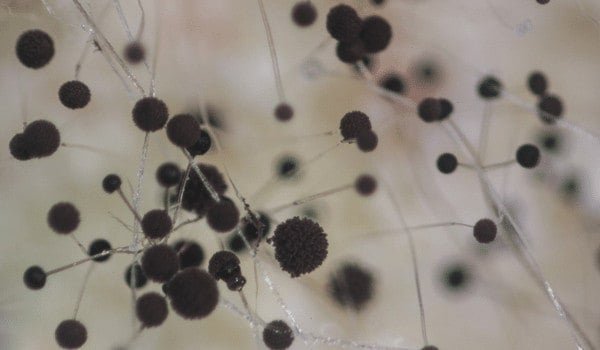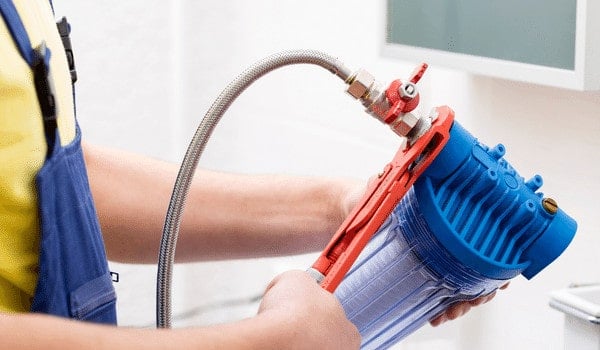Mold is unpleasant anywhere — but inside a water filter, it’s especially unsettling. You might be wondering: Is it safe? Could it make someone sick? And does it mean the system’s ruined?
There’s no need to panic — most of the time, it’s fixable. Let’s break down why mold shows up, how to get rid of it, and what you can do to keep it from coming back.
🧼 Quick Take: How to Clean Mold From Filters
For cartridge-based filters:
- Shut off water and unplug the system (if powered)
- Disassemble the filter and remove visible debris
- Soak parts in a bleach-and-water solution (or vinegar if preferred)
- Rinse thoroughly and air dry before reassembly
- Run clean water through before using again
- Check regularly for signs of mold or mildew
For tank-based filters:
- Discard the old media
- Fill tank with a diluted bleach or vinegar solution and let it sit
- Scrub remaining parts while the tank soaks
- Rinse thoroughly and let everything air dry
- Refill with clean, preferably bacteriostatic media
🧠 Good to know: Tank-style systems are less likely to grow mold — but harder to clean when they do.
🦠 Mold vs. Mildew: What’s the Difference?

Mold and mildew are often used interchangeably, but they’re not the same — especially when it comes to your water filter.
- Mold is a fungus that grows in damp, enclosed spaces. It tends to show up on natural materials like paper or cloth and can appear in different colors — usually black or green, sometimes even pink.
- Mildew is technically a type of mold, but the word is usually used to describe lighter, surface-level growth — often gray or white — that shows up in places like bathrooms or basements.
When it comes to water systems:
- Mold is the more serious concern. If it’s growing inside a filter cartridge or tank, it could end up in your tap water.
- Mildew may appear as black specks on filter housings or cartridges — especially paper ones — but still indicates mold activity.
💡 If water isn’t moving regularly through your system — like during a vacation or low usage — any stagnant areas become ideal for mold growth.
🧩 How Does Mold Get Into a Water Filter?

Mold spores are everywhere — but they don’t usually thrive inside sealed plumbing. If you’re seeing mold in your filter, it’s often a sign that something’s off.
Here are some common ways mold finds its way in:
- Tiny leaks – A pinhole in a pipe, pressure tank, or water heater can let spores sneak in from the outside.
- Damaged well cap – On private wells, a cracked or loose cap is a direct pathway for airborne contaminants.
- Old or poorly maintained filters – When filters aren’t changed regularly, debris can build up — and that gives mold a food source and a place to grow.
- Stagnant water – Filters work best when water flows through them consistently. If a system sits idle for too long, that trapped moisture becomes mold’s playground.
- Organic filter materials – Some filters (especially paper ones) contain materials that mold likes to grow on.
🧠 Pro Tip: Mold doesn’t usually grow on metal or plastic piping — but filters and housings are a different story. They’re more exposed and often made of materials mold can live on.
🚫 Do Water Filters Remove Mold?

Some filters can remove mold — but not all of them. It depends on the type of system you’re using.
Here’s a quick breakdown:
- Carbon filters Standard carbon filters can trap some mold spores, but they’re not reliable for mold removal. They’re more effective when combined with other media, like KDF.
- KDF media KDF isn’t a filter on its own — it’s a specialized additive that helps control bacteria, algae, and fungi inside a filter. It’s often combined with carbon to reduce microbial growth. Learn more about KDF media here.
- UV filters Ultraviolet light scrambles mold DNA, stopping it from spreading. It won’t remove mold physically, but it neutralizes spores and keeps your system clean.
- Reverse Osmosis (RO) RO systems use a membrane fine enough to remove mold spores, bacteria, and other tiny particles. It’s one of the most effective ways to clean drinking water — but it only works at a single tap unless you invest in a whole-home RO system.
💡 Good to Know: Most carbon-based filters won’t stop mold from growing inside the housing if conditions are right. If you’re using one, check for buildup and clean the canister regularly.
| 🧪 Filter Type | 🛡️ Mold Protection Level |
|---|---|
| 🧱 Standard Carbon Filter | May trap some spores, but not reliable for mold removal |
| ⚡ Carbon + KDF Media | Helps control mold growth inside the filter |
| ☀️ UV Filter | Neutralizes mold spores with UV light |
| 🚰 Reverse Osmosis | Removes mold spores through fine membrane filtration |
⚠️ Is Mold in a Water Filter Harmful?

Mold affects people in different ways — and some types are more irritating than others, especially if you’re sensitive to it.
Here’s a quick overview of how different mold types may affect health:
- Allergenic molds These are the most common. They can cause: sneezing, congestion, or mild respiratory symptoms in people with allergies.
- Pathogenic molds These are more likely to affect individuals with weaker immune systems. Most healthy adults won’t react, but it can be a concern for young children or the elderly.
- Black or toxic molds A few types produce compounds that may irritate the skin or airways. Reactions vary, but it’s best to limit contact whenever possible — especially when changing a filter.
🧤 Helpful Tip: If you’re handling a moldy cartridge, wear gloves and avoid breathing in dust or dried particles. Mold is more likely to become airborne once it’s dry.
🧼 How to Spot Where Mold Is Coming From

Mold can show up inside or around your filter — and where you find it can tell you a lot about what’s going on.
Here’s what to look for:
- Mold on the outside of the system If you only see buildup on the outer housing, it could be from condensation. Try adding a dehumidifier or insulating the filter to cut back on moisture.
- Mold inside the cartridge or tank This usually points to an issue with the incoming water — especially if it’s stagnant or hasn’t been filtered in a while.
- Paper filter cartridges Mold loves organic materials, and paper filters are especially vulnerable if left in place too long.
- Pitcher filters (like Brita) These can grow mold if they aren’t cleaned regularly. The pitcher itself can hold moisture and organic matter — creating the perfect spot for growth.
🧽 Pro Tip: Clean pitcher filters weekly with warm, soapy water. Let them air dry before putting in a new cartridge. Here’s how to tell if your carbon filter is breaking down.
💧 Think It’s Your Water? Here’s What to Check

Sometimes, the mold isn’t coming from the filter — it’s coming from the water itself. If that’s the case, finding the source early is key.
Here’s where to start:
- 📞 Call your water provider (if on city water) Mold in municipal supplies is rare, but it’s not impossible — especially after a line break or equipment failure. If something seems off, it’s worth reporting.
- 🧪 Test your water Just because water looks clear doesn’t mean it’s free of spores or bacteria. We recommend a lab-grade test like Tap Score’s mold and fungus panel to check for common contaminants.
- 🔦 Inspect your plumbing Small leaks — even pinhole-sized — can pull in spores from the surrounding environment. Grab a flashlight and check pipes, fittings, water heaters, and pressure tanks.
- 🛠️ Have your well inspected If you’re on well water, a cracked well cap or aging casing might be letting in surface contaminants. A professional well check can rule that out.
💡 Keep in mind: Stagnant water anywhere in your system — especially in underused pipes or storage tanks — creates the perfect place for mold to take hold.
🧽 How to Get Rid of Mold in Water Filters

The good news? Most mold issues inside filters can be cleaned up — as long as the problem hasn’t spread too far. Just follow the right steps based on your system type.
🧱 Cartridge-Based Systems
If you spot mold on a filter cartridge, it’s best to toss it. Cleaning solutions can damage the media, and the risk of recontamination isn’t worth it.
Here’s how to clean the housing:
- Remove the old filter (wear gloves if mold is visible)
- Mix ¼ cup of bleach in a quart of hot water (or use a white vinegar solution as a gentler alternative)
- Scrub the inside of the housing with a soft brush
- Rinse thoroughly with hot water
- Let it air dry fully before installing a new filter
🧠 Want a full walkthrough? Here’s how to change a whole-house water filter the right way.
💧 Pitcher-Style Filters (e.g., Brita)
- Empty and rinse the pitcher
- Spray or soak with vinegar and water solution
- Wash with warm soapy water
- Air dry completely before inserting a new cartridge
🛢️ Tank-Based Filter
These are more involved to clean, but here’s a safe method:
- Discard the used media
- Fill the tank with a diluted bleach or vinegar solution
- Let it sit for at least an hour
- Scrub any removable parts while you wait
- Rinse the tank thoroughly and allow it to dry
- Refill with bacteriostatic media to help prevent mold in the future
🧂 What About Water Softeners?
Most softeners are mold-resistant due to the salt, but they’re not immune. If yours smells musty after sitting idle, pour 1–2 cups of bleach into the brine tank and run a regeneration cycle. Just double-check your model’s manual first — some require a specific cleaner.
Getting rid of mold in water filters is surprisingly straightforward, but solving recurring problems is more of a challenge. Let’s explore the solutions for moldy filters and water pipes.
🧼 How to Clean Moldy Pipes
If mold is coming from your plumbing, a deep clean can help — especially in underused sinks or drains where moisture lingers.
Here’s a safe, DIY method:
- Pour 1 cup of baking soda down the affected drain (kitchen or bathroom)
- Let it sit overnight to help break up buildup
- The next day, add 2 cups of white vinegar — it’ll fizz and foam
- Once the reaction settles, pour in half a gallon of hot (not boiling) water
♻️ You can repeat this process weekly if needed — especially in areas with slow drainage or a musty smell.
💡 Tip: If you suspect mold deeper in your plumbing or water heater, professional cleaning may be needed. Storage tanks and heaters should be flushed separately.
🔄 Recurring Mold Problems: Why It Keeps Coming Back

If mold keeps showing up even after cleaning, there’s usually a deeper issue. Persistent growth often means your water source, plumbing, or equipment is seeding new spores.
Here’s what could be going on — and what to do about it:
🕳️ A Faulty Well or Damaged Plumbing
If your pipes or well system have small cracks or aren’t sealed properly, outside contaminants (including mold spores) can get pulled in. Even a worn-out well cap or loose fitting can be enough.
🔧 Fix it: Have your well professionally inspected, and check pipes and fittings for hidden leaks.
🌊 Mold in Your Water Source
If the water entering your home is already contaminated, cleaning filters won’t be enough — mold will just keep reappearing.
🧪 Fix it: A full water test is key. If mold or fungal spores are found, you’ll need to treat the water before it enters your home.
🧫 Inside-the-Filter Growth
Some filters, especially paper-based cartridges or units left idle, are prone to internal mold growth if they’re not replaced on schedule.
🗓️ Fix it: Change cartridges regularly, and don’t let filters sit stagnant. Backwashing filters should run on a consistent cycle.
🧠 Long-Term Solutions for Mold Prevention
If mold is confirmed and your system needs added protection, here are a few options:
| 💡 Solution | How It Helps Prevent Mold |
|---|---|
| Chlorination | Kills mold and other microbes at the water’s entry point |
| UV Filter | Neutralizes mold spores with ultraviolet light — no chemicals |
| Reverse Osmosis (RO) | Filters mold spores from drinking and cooking water at the tap |
| Carbon + KDF Media | Helps limit mold growth inside whole-house filter systems |
🧼 How to Prevent Mold in Water Filters

The best way to deal with mold? Keep it from growing in the first place. Here’s a few solid tips to keep you on the right side.
🧃 If You Use Cartridge-Based Filters:
- Replace cartridges on schedule — don’t wait until water flow slows
- Clean the filter housing every time you change the cartridge
- Store backup filters in a dry, sealed container
🌀 If You Have a Backwashing System:
- Make sure it cycles at least once a week
- Avoid extended idle periods — especially if you leave town
- If compatible, consider using bacteriostatic media to help reduce mold
🧪 Extra Tip:
Not sure if your system is mold-prone? Check your setup with a quick test or inspection — especially if you’ve noticed odors, discoloration, or slimy residue.
🧠 Final Thoughts
Mold in a water filter isn’t something anyone wants to deal with — but it doesn’t always mean something’s broken or unsafe.
With regular maintenance and a few preventative steps, most mold issues can be handled quickly and won’t come back. And if it turns into a recurring problem, there are reliable ways to clean your system or upgrade it to stop mold at the source.
Whether it’s replacing a filter, checking for leaks, or making a few system tweaks — a little attention now can save you from bigger cleanup later.
 153 people found this helpful. Was this guide helpful to you?
153 people found this helpful. Was this guide helpful to you? 

